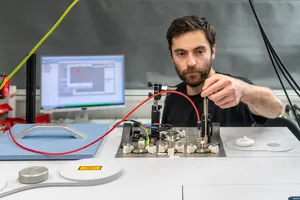Plasmonic Energy: On the Track of Electrons
News |

The key to optimally harnessing solar energy for chemical reactions lies at the interfaces, specifically in the electron transitions. Scientists from LMU and Rice University, the latter as Hans Senior Fischer Fellows at the Institute for Advanced Study at the TU Munich, propose a new way to rationalize these concepts when employing plasmonic materials for such catalytic processes. They offer a new framework to rationalize these processes, bringing a holistic description of plasmon-molecule interaction that advances the design of energy materials.
Those researching surface chemistry and physics know that interfaces hold surprises. This was precisely expressed by the Nobel laureate Wolfgang Pauli, who died in 1958, and to whom is attributed the phrase: “God made the bulk; the devil invented surfaces.” This suggests that a surface can exhibit astonishing and unpredictable properties, unlike the ordered, well-understood bulk. Nano-effects, such as increased reactivity or differing optical properties of nanoparticles, make this quote more relevant than ever.
Unique Review Article Combines New and Existing Knowledge
“Every piece of knowledge helps us shed light on this fascinating world of surfaces and interfaces and ultimately brings us closer to the overarching goal: developing materials that can efficiently utilize solar energy for chemical reactions,” explains Dr. Andrei Stefancu, who researches plasmonic materials as a Humboldt research fellow in the team of Prof. Emiliano Cortés at LMU Munich. With Prof. Naomi Halas and Prof. Peter Nordlander (both from Rice University in Houston, Texas), the LMU scientists have published an article in the journal Nature Physics that presents a unique, holistic view of fundamental electron transfer processes. “We all felt that it was important for current researchers to connect with the foundational understanding developed much earlier and with very different experimental methods,” says Halas, who, like Nordlander, is a Hans Fischer Senior Fellow (funded by the Excellence Cluster e-conversion) at the Institute for Advanced Study at TU Munich and is also involved in other e-conversion projects. “The article presents a unified understanding of the physics of surface science, established more than four decades ago, with the same phenomena emerging in different contexts from current studies of nanophotonics and plasmonics,” emphasizes Halas.
The Potential of Plasmonic Chemistry
Plasmonic chemistry, a promising research field at the interface of chemistry and physics, has the potential to revolutionize the efficiency of solar cells and the possibilities of photocatalysis and sustainable chemical production. At its core are metallic nanostructures, whose electrons can be very efficiently excited by sunlight. This process effectively stores solar energy in the electrons of the metal nanoparticle, which can then transfer this energy to molecules adsorbed on its surface, enabling chemical reactions. This potential for efficient energy transfer is a source of inspiration and hope for the future of solar energy utilization, as explained by Prof. Emiliano Cortés, whose work on supercrystals that can efficiently generate hydrogen using sunlight has already made significant waves in the field.

What is the Best Way to Transfer Energy to a Molecule?
Based on their research and an extensive literature review, the interdisciplinary team now precisely discusses how an electron is transferred from the metal nanoparticle to a molecule and what pathways can be taken for this fundamental process. “We have identified that several mechanisms that involve energy transfer or exchange between an electron, a nanoparticle, and an adsorbed molecule can be rationalized under the same fundamental framework,” explains Stefancu. The team mastered several challenges during their two-year work on the paper. On the one hand, the researchers placed the knowledge blocks from several decades into a temporal context. On the other hand, the experts managed to visualize the various underlying physical effects. Prof. Nordlander declares the goal: “To clearly and simply illustrate the precise physical mechanisms being discussed, clear schematics were critically needed.” The review shows that the essential common factor underlying the range of physical phenomena reviewed is electron scattering against an adsorbate molecule. “This highlighting of one of the most basic physical effects will both inform scientists in a much broader range of disciplines,” says Nordlander.
This Nature Physics article is the first result of this team within the Fellowship Program of e-conversion. It once again highlights the value of research funding for international and interdisciplinary collaboration in the field of energy research. With their unique framework, the team has opened the door a bit wider to designing new energy materials that will make energy conversion more efficient in the future. This efficiency improvement could significantly improve the options for industrial use, making the practical implications of the research clear to the audience.
PUBLICATION
Electronic excitations at the plasmon–molecule interface
Andrei Stefancu, Naomi J. Halas, Peter Nordlander, Emiliano Cortés
Nature Physics, 20, 1065–1077 (2024)
https://doi.org/10.1038/s41567-024-02537-6
CONTACT
Prof. Emiliano Cortés
Nano Institute Munich, Faculty of Physics
Ludwig-Maximilians-Universität München
Email: Emiliano.Cortes(at)lmu.de
Website: www.nano-energy.org
Twitter/X: @HybridNano